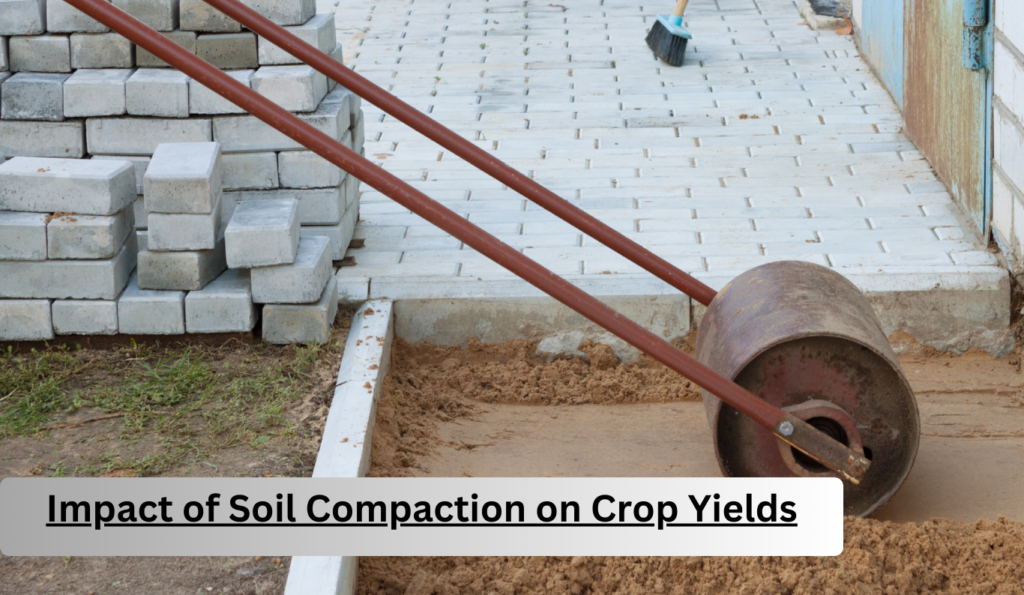Impact of Soil Compaction on Crop Yields
Soil compaction is a serious issue in agriculture that occurs when soil particles are pressed tightly together, reducing pore space. This happens due to heavy machinery, livestock trampling, or continuous cropping without soil management. Compacted soil affects plant growth, water movement, and overall crop production.
1. Reduced Root Growth and Penetration
- Compacted soil creates a hard layer that restricts root expansion.
- Roots struggle to access deeper soil layers where moisture and nutrients are stored.
- Shallow root systems lead to weak plants, reduced nutrient uptake, and vulnerability to drought.
Example: Corn and wheat require deep root penetration for stability and nutrient absorption. Compacted soil limits root growth, reducing yields.
2. Poor Water Infiltration & Drainage
- Compaction decreases pore space, preventing water from filtering into the soil.
- Water accumulates on the surface, leading to waterlogging in wet conditions.
- In dry conditions, less water is stored, making crops more vulnerable to drought stress.
Example: Soybeans in compacted soil may experience drought stress because the roots cannot access deeper moisture, even when water is available below the compacted layer.
3. Decreased Oxygen Supply to Roots
- Healthy soil has air spaces that allow oxygen movement to plant roots.
- Compaction reduces soil aeration, suffocating roots and soil microbes.
- Low oxygen levels slow down nutrient absorption, causing yellowing and weak plant growth.
Example: In compacted soil, crops like potatoes may have stunted growth and poor tuber formation due to a lack of oxygen.
4. Reduced Nutrient Availability
- Soil compaction prevents nutrient movement within the soil.
- Microbial activity, which helps release nutrients, slows down in compacted areas.
- Plants absorb fewer nutrients, leading to deficiencies in nitrogen, phosphorus, and potassium.
Example: Wheat growing in compacted soil may suffer from nitrogen deficiency, resulting in poor tillering and reduced grain yield.
5. Increased Risk of Soil Erosion
- Compact soil does not absorb rainwater, causing surface runoff.
- Runoff washes away fertile topsoil, which contains organic matter and essential nutrients.
- Over time, erosion depletes soil fertility, reducing yields.
Example: In sloped fields, compacted soil causes severe runoff and erosion, leading to gullies and loss of valuable cropland.
6. Delayed Seed Germination and Poor Emergence
- Hard, compacted surfaces make it difficult for seeds to sprout.
- Uneven seed emergence leads to inconsistent plant growth and lower crop yields.
- Crops may experience “root curling” as roots struggle to push through compacted layers.
Example: In rice fields, compacted soil can delay germination and result in uneven crop stands, affecting productivity.
7. Increased Need for Fertilizers and Irrigation
- Farmers compensate for poor soil conditions by adding more fertilizers and water.
- Compacted soil does not absorb fertilizers well, leading to nutrient leaching or runoff.
- Excessive irrigation is needed because compacted soil does not retain water properly.
Example: Farmers growing alfalfa in compacted soil may need higher irrigation rates and additional fertilizers to maintain yields.
8. Higher Energy & Equipment Costs
- More fuel and power are required to plow and till compacted soil.
- Heavy machinery struggles to break through hard soil layers, increasing wear and tear on farm equipment.
- More labor and time are needed for planting and soil preparation.
Example: A tractor may need more passes over the field, consuming extra fuel, to break up compacted soil before planting.
How to Prevent & Fix Soil Compaction
A. Prevention Methods
- Limit Heavy Machinery Use
- Avoid driving tractors or combines on wet soil.
- Use controlled traffic farming to reduce pressure on soil.
- Use Cover Crops
- Deep-rooted plants like alfalfa and radish break up compacted layers.
- Cover crops also improve soil organic matter and structure.
- Rotate Crops
- Crop rotation with legumes and deep-rooted plants improves soil health.
- Prevents continuous stress on the soil from one type of crop.
- Reduce Tillage
- Excessive tillage compacts soil over time by breaking down soil structure.
- No-till or strip-till farming helps maintain natural soil aeration.
B. Methods to Fix Compacted Soil
- Subsoiling (Deep Tillage)
- Special equipment (subsoilers) can break up compacted layers below the plow depth.
- Organic Matter Addition
- Compost, manure, and crop residues improve soil structure and porosity.
- Aeration & Soil Amendments
- Using gypsum can help improve clay soils by reducing compaction.
- Mechanical aerators can help loosen compacted areas.
Conclusion
- Soil compaction reduces crop yields by restricting root growth, water movement, nutrient absorption, and aeration.
- It increases production costs due to extra fuel, fertilizers, and irrigation needs.
- Preventing compaction with proper soil management techniques ensures long-term soil fertility and high crop productivity.



